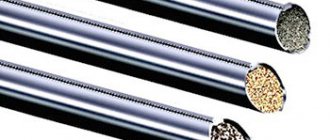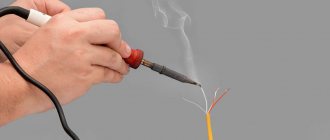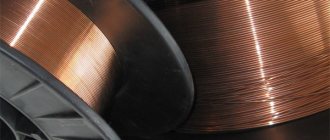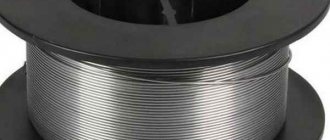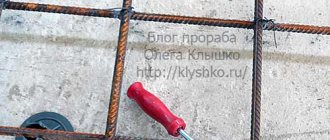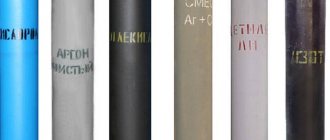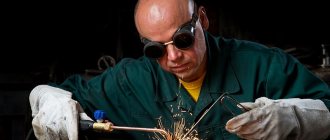In the modern world, there is not a single industrial enterprise that does not use electric arc welding in its production activities. Thanks to this factor, the domestic market for semi-automatic devices is constantly growing and actively developing.
Today it is represented by a wide range of technical means, specific devices and consumables, the most popular of which is welding wire for semi-automatic machines. This important component must match its characteristics as closely as possible to the properties of the metal from which the parts being connected are made. Therefore, a large number of filler products have been developed that are most suitable for a certain type of work.
Types of wire
Welding wire is an indispensable element for successful work operations in various industries and utilities. With its help, several metal segments are connected into a solid structure.
The features of this filler material include ease of use and excellent quality of work performed. Proper selection of wire not only improves the reliability of the weld, but also significantly increases productivity.
Wire for semi-automatic machines is usually supplied in coils, coils and coils. The weight of the first type of packaging sometimes reaches 1.3 tons. The weight of the second type of container can vary from 15 to 120 kilograms. The mass indicators of the third form of packaging range from 5 to 18 kilograms.
Often the wire is placed in boxes or plastic bags. If the product does not have packaging, then before use the wire is dried at a temperature of 200°C.
Powder
This wire is a hollow object made of metal, the free space of which is filled with powder and flux.
These materials help protect the seam from exposure to oxygen and harmful substances formed during the welding process. An important factor here is also ensuring the safety of the respiratory system of the specialist performing technological work.
The use of special additives in welding wire facilitates ignition of the arc and helps reduce metal spattering, which has the most favorable effect on the formation of a high-quality seam. The arc burns in a flux medium, which allows you to protect the area of the welded area from the negative influence of the environment.
For work using flux-cored wire, heavy gas cylinders are not required, which are associated with many hassles: storage, refilling and possible leakage.
Copper-plated
Copper-plated wire is a product designed to work with carbon and low-carbon steels. It is coated with a special copper compound and is used for welding objects in a protective gas environment.
Non-ferrous metal wire
Since ancient times and on different continents, copper and bronze wires have been used by our ancestors to make jewelry. And now hardware made of non-ferrous metals is in demand in the industrial, medical and household sectors. The cross-section of wire made of non-ferrous metals starts from 0.03 mm. Although such metal threads are very thin and ductile, in general, colored wire is quite durable, and most importantly, resistant to corrosion. It can be used even in aggressive environments, where it serves for a long time and retains its aesthetic appearance for a long time.
Meshes made of colored wire are used for separation and filtration of many liquids and gases. The chemical and pharmaceutical industries use laboratory and test sieves made from this material. The use of protective screens in the fields of instrument making and electrical engineering is also common.
Wire of this type is made from the following non-ferrous metals:
- brass (semi-tombak);
- nickel;
- bronze;
- copper;
- fechral;
- nichrome.
Marking
The basic requirements regulating all issues of production of wire for welding work are presented by GOST 2246-70 . Today, about 80 varieties of this type of product are manufactured. And in order to understand what a particular type of product is, it is assigned a certain label, which helps to understand the composition of the product and its characteristics. A good example is the popular welding wire sv08g2s .
Its decoding is represented by the following values:
- The combination of the letters “st” indicates that this product refers to welding wire;
- The combination of numbers “08” indicates the amount of carbon (in hundredths) contained in the product;
- The letter “g” emphasizes the presence of manganese in the wire;
- The number “2” is the volume of manganese in the element;
- The letter “c” indicates the presence of silicon in the wire, but if there is no number after the letter designation, this means that the product contains less than 1%, but more than 0.5%.
Based on the markings stated above, we can say that the presented product is an alloyed low-carbon wire, which contains additives such as silicon and manganese.
Responsible Cooling
After this comes the cooling stage of the wire rod. It can be natural (in this case, the wire rod receives the VO marking) and accelerated (UO marking).
Natural cooling produces a softer and more flexible wire rod (and then wire), while accelerated cooling produces a more rigid and elastic one. Industrial fan installations or water flows can speed up the cooling of the wire rod. With the first cooling method, the marking of the wire rod will indicate YO1, and with the second - YO2.
The rapidly cooled wire rod (intended for the production of wire in the future) is cleaned of scale, which should not be more than 18 kilograms per ton on the UO1 wire rod, and no more than 10 kg/t on the UO2 wire rod. Scale is removed either mechanically (then the wire rod is passed through a special descaling machine), or chemically, when the surface of the wire rod is etched with a solution of sulfuric acid with the addition of table salt, trisodium phosphate and other additives.
The chemical method gives a smoother surface, but it is also fraught with the acquisition of the so-called metal. "etching fragility". The mechanical method is safe in this regard, because - but it is less reliable and produces a rough surface.
The diameter of the wire
Wire for semi-automatic devices comes in the following diameters:
- 0.6 mm;
- 0.8 mm;
- 1.0 mm;
- 1.2 mm;
- 1.6 mm.
Such dimensional indicators allow us to fully satisfy the needs of professional welders. For highly specialized purposes, products with a diameter from 3.0 to 6.0 millimeters are perfect.
The required wire size is selected in accordance with the characteristics of the welding current and the thickness of the elements being connected.
Mechanical performance
- tensile strength: from 690-1370 n/mm2 to 440-690 n/mm2
- elongation ratio:12-18%
To summarize, steel wire is a universal raw material for the production of various products, which is available to any consumer.
Photo of steel wire below in our gallery.
Popular brands
The most popular brands of welding wire presented on the domestic market are:
- Sv-08GSMT. This type of product belongs to copper materials and is used in welding operations using automatic and semi-automatic machines. The wire works well with carbon metals and alloys that contain a low percentage of alloying components. It is characterized by a high level of resistance to tensile loads. This parameter is in the range of 1000-1300 MPa. This grade of wire is widely used for joining thin-walled parts operating under high pressure. Welding is carried out in an environment of protective gases (argon and carbon dioxide);
- Sv-06Х19Н9Т. This grade of wire is intended for working with stainless steel in a protective gas environment. Thanks to the content of elements such as chromium, manganese and nickel, it has good corrosion resistance. Used in the production of food industry products;
- PP2DS. This is a representative of cored wire. This brand allows operations to be carried out in strong winds, which gas shielded welding cannot do. The wire is intended for connecting parts made of steel (carbon and low-alloy), cast iron and non-ferrous metals. Used in shipbuilding and oil industry;
- OK Autrod 19.40 . This wire is from a foreign manufacturer ESAB. It is used for working with rolled aluminum bronzes and for surfacing anti-corrosion layers on metal parts. Its yield strength is 175 MPa, and its strength reaches 400 MPa. Welding operations are carried out in pure argon. This product is used in the chemical industry and automotive industry.
Tools
0 votes
+
Vote for!
—
Vote against!
In everyday life, welding work is not often required, unlike in the industrial sector, where welding is an integral part of the process. However, when the need arises to cook something, the question also arises of how to do it, using what unit, what consumables are needed. The choice of welding method and consumables directly depends on what materials need to be welded together. For example, to weld refractory and non-ferrous metals, you have to use welding wire, but not just what kind, but a different type is selected for each case. Often the question of how to choose a wire for welding confuses a novice welder or a craftsman who has recently used the machine. In this article we will talk about what kind of welding wire there is and how to select it for certain cases.
- Welding wire marking
- Types of welding wire
- Welding filler wire
- Flux Cored Wire for Welding
- Steel Welding Wire
- Aluminum Welding Wire
- Wire for welding stainless steel
- Copper Welding Wire
- Wire for welding cast iron and nickel alloys
- Titanium Welding Wire
- Welding wire diameter
Welding wire marking
For welding wire, the most important thing is the chemical composition; it is this that determines the choice. You can recognize it by reading the markings on a domestically produced product, which complies with GOST 2246-70 , or foreign markings according to AWS .
Since the production of welding wire in the CIS countries is very well established, we will first look at the designations on domestically produced products. First, let's decipher the letter designations:
Example: SV-08G2S means
- SV – welded wire;
- 08 – mass fraction of alloyed elements in the wire composition. In this case, the wire contains 0.08% carbon;
- G – contains manganese;
- 2 – no more than 2% of the element indicated before the number. In this case, no more than 2% manganese;
- C – contains silicon. In this case, there is no number after the designation “C”, this means that the silicon content is less than 1%, but more than 0.5%.
Example: SV-06Х21Н7БТ means Welding wire, which contains 0.06% carbon, 21% chromium, 7% nickel, alloyed with niobium and titanium.
Example: SV-08Х19Н10МЗБ means Welded wire, which contains 0.08% carbon, 19% chromium, 10% nickel, 3% molybdenum, alloyed with niobium.
Sometimes in markings according to modern standards, aluminum is designated by the letter “A”.
Example: SV-A97 is a welding wire consisting of 99.97% aluminum.
Example: SV-AK5 is a welding wire consisting of 95% aluminum and 5% silicon.
To order a particular wire, you must accurately indicate the marking. Unfortunately, international standards are not as easy to read as GOST standards, so if you haven’t found the required domestically produced wire, contact a specialist so that he can select a foreign analogue for you.
Types of welding wire
In total, there are about 77 brands of domestically produced welded wire, which can be divided into 3 main categories:
Thus, the wire is divided according to the area of application: one is used for low-alloy steels, the other for carbon steels, and the third for welding non-ferrous metals or submerged arc welding.
For example, the SV-08G2S wire considered above is alloyed, since it contains more than 2.5% alloying metals: 2% manganese and more than 0.5% silicon.
Welding filler wire
Welding wire is a so-called filler material. In the process of welding two elements, the wire is brought to the seam and melts along with the edges of the metals, filling the seam. Thus, the filler wire serves as a material that makes up for losses due to metal spatter during welding. In addition to wire, filler rods and tapes can be used as filler material.
The main requirement when choosing a filler wire is that it must have the same chemical composition as possible as that of the materials being welded . For example, you need to pay attention to the carbon content. The plasticity of the seam depends on the amount of this element. Sulfur and phosphorus are considered negative impurities. To ensure a high-quality, reliable weld and long service life of the product, the composition of the filler wire should be as close as possible to the composition of the metals being welded.
The second requirement is that the melting temperature of the filler wire should be slightly lower or the same as that of the metals being welded . Pay attention to when the wire begins to melt; if this happens later than the metals being welded, then there is an extremely high probability that the metal on the elements being welded will burn through. And of course, it is important that the melting occurs evenly, then the seam will be neat (without defects) and more durable. If the melting temperature is chosen incorrectly, this threatens the appearance of cracks in the weld, high slagging of the seam, spattering of the metal edges, and, worst of all, the presence of hidden cavities inside the weld.
General requirements for filler wire:
- The thickness of the filler wire must correspond to the thickness of the elements being welded.
- The wire must be clean, free of scale, rust, traces of oil or paint, or other contaminants.
- The wire should melt evenly without spattering.
- The resulting weld should be smooth, without cracks or pores in the metal.
Most often, filler wire is used when welding in a shielding gas environment, which provides a clean and reliable weld, protecting the weld pool from oxygen. Argon, helium, carbon dioxide or mixtures of argon and carbon dioxide can be used as shielding gases.
Wire for argon arc welding of non-ferrous metals should have a similar composition. For example, for welding aluminum, wire SV-97, SV-A85, SV-AMts or its foreign analogues ER 1100 (OK Autrod 1070 (OK Autrod 18.01)) is used. These materials are resistant to chemical and atmospheric influences; two weldings are used for products made of pure aluminum or its ductile alloys (AD1, AMts).
Wire for semi-automatic welding of low-alloy steels is the market leader in welding consumables, since the vast majority of steel products belong to this category. The most common filler wire is the already known SV-08G2S, which is produced both in the usual version - without coating, and copper-plated - with anti-corrosion protection. The use of wire with anti-corrosion copper-plated protection makes the product of higher quality, the arc burns more steadily during the welding process, and the copper tip is consumed more slowly.
The filler wire welding process uses flux. Substances called “fluxes” make it possible to make the structure of the weld as ideal as possible, thereby protecting the metal in the weld area from premature destruction. Thanks to fluxes, the surface of the metal in the welding zone is even and smooth, and the degree of extensibility of the metal in the weld zone is high. All this makes the product more reliable and durable.
The following are used as flux:
- Boric acid.
- Borax.
- Silicon oxides.
- Sulfur.
Most often, filler wire is sold in coils. Before use, it must be straightened and cut into pieces of the required length. If the wire will not be used for a long time, it must be protected by wrapping the coil with special waterproof paper.
Flux Cored Wire for Welding
To improve the welding process in field conditions or open spaces, so-called flux-cored wire is used. This makes it possible to make high-quality seams, while spending less time and effort on mechanizing the process and cleaning the material from splashes. This type of wire is divided into two subtypes: gas-shielding flux-cored wire and self-shielding flux-cored wire.
Flux-cored gas shielding wire is intended for semi-automatic and automatic welding of low-alloy and carbon steels in a protective gas environment: carbon dioxide or its mixtures with argon.
Due to its high penetration, this wire can be used for welding fillet, lap and butt joints in almost one pass. The advantages of flux cored gas shielding wire are low level of spattering, slag crust is easily separated, high resistance to porosity and unwanted slag inclusions, stable jet transfer.
Flux cored gas shielding wires are divided into the following types:
New types of such wire make it possible to achieve an ideal weld shape, low spatter, high weld speed, high deposition rate and low smoke if used for welding in protective mixtures with a high content of argon.
Flux cored self-shielding wire is also called flux-cored wire or simply self-shielding. Its core contains all the necessary slag-forming, protective and deoxidizing additives. As a result, there is no need to use bottled gas. This greatly simplifies the task, since there are many problems and dangers associated with the use of gas. Cored wire allows you to avoid a number of hassles with storing, certifying gas cylinders, refilling them and moving them from place to place.
If during conventional semi-automatic welding a protective pool was formed using a gas flow that came out of the torch nozzle, then wire for welding without gas allows you to create protection in a different way - during the welding process, the flux located in the wire core evaporates and forms a protective bubble directly at the welding site . It cannot be washed off by a stream of air, so such wires are used for welding outdoors in strong winds.
Advantages of cored self-shielding wire:
- Open arc. This allows the operator to monitor what is happening and redirect the deposited metal.
- Guaranteed perfect seam composition.
- You can weld in any position.
- The equipment is compact, there is no need to use gas cylinders, as well as equipment for supplying gas and flux.
- A special coating of the wire with lubricant makes it possible to withstand the mechanical pressure of the rollers that feed the material into the welding zone.
For open arc surfacing, wires with a diameter of 2.0 – 3.0 mm are used, and for submerged arc surfacing, wires with a diameter of 3.6 mm are used. For welding large-sized products, wire with a diameter of 5.0 mm is used.
The welding technology using self-shielding wire does not differ from the technology using solid welding filler wire. The only limitation is that the semi-automatic welding machine must have a No Gas mode.
Steel Welding Wire
Copper-plated wire SV-08G2S is used for welding pipelines, boilers, structural steel products, as well as containers that will be under high pressure during operation. It has also proven itself well when working with thin metal and welding in any position. The tensile strength of this wire is in the range of 900 – 1350 MPa.
The table below shows the grades of welding wire that can be used for welding steel under gas protection conditions - argon, carbon dioxide or a mixture of these gases.
Table 1. Wire for welding steel in shielding gases.
Aluminum Welding Wire
For welding aluminum and its alloys, wire is used consisting of pure aluminum or with the addition of magnesium and silicon, depending on the composition of the alloy being welded. Most often, products are made of aluminum (99%), aluminum-magnesium alloy (4.8 - 6% magnesium and the rest aluminum) and aluminum-silicon alloy (95% aluminum and 5% silicon). For each of them, its own wire is selected, this can be easily seen from the table.
Wire for argon welding of aluminum is used with flux, which can have the following composition: potassium chloride 27 - 33%, lithium chloride 9 - 12%, sodium chloride 42 - 48%, potassium fluoride 12 - 16%.
Table 2. Wire for welding aluminum and its alloys.
Welding of aluminum parts is common in the food industry.
Wire for welding stainless steel
Welding of products made of stainless steel or heat-resistant alloys is carried out using a semi-automatic machine using shielding gas. The welding wire is made of high-alloy heat-resistant steel. Stainless steel welding wire contains silicon and carbon. Silicon ensures the strength of the weld and its quality. Carbon prevents the formation of intercrystalline corrosion.
In addition to silicon and carbon, stainless steel wire may contain chromium and nickel. This wire is more resistant to corrosion. It is used in mechanical engineering, food and light industry, oil industry and shipbuilding.
Table 3. Stainless steel welding wire for welding stainless and heat-resistant steels.
Copper Welding Wire
The use of copper in industry and power engineering is associated with the exceptional properties of copper to resist corrosion in aggressive environments. The purer the metal composition, i.e. The more copper it contains and the fewer impurities, the higher the corrosion resistance. This is why increased demands are placed on copper-based materials and filler wires.
Depending on the amount of impurities, the following grades of copper are distinguished:
Due to the fact that the welds of products made of pure copper must retain the entire complex of physical properties for which this metal is used - thermal conductivity, electrical conductivity, corrosion resistance and density, extremely stringent requirements are imposed on welding wire. And during the welding process, the seam should not become contaminated with impurities.
Welding wire for copper is made of electrolytic copper, and during the welding process a flux of borax 48 - 53%, sodium chloride 32 - 38%, boric acid 10 - 14% can be used.
Table 4. Wire for copper welding.
Wire for welding cast iron and nickel alloys
For welding nickel, wire alloyed with metals such as manganese (no more than 2%), silicon (no more than 0.8%), magnesium (no more than 0.3%) and titanium (no more than 0.1%) is well suited. Manganese is necessary for deoxidation and binding of sulfur, silicon makes the metal more fluid, magnesium binds those sulfur residues that remain after manganese. It is advisable to choose the diameter of the wire for welding nickel equal to half the thickness of the metal of the products being welded.
Cast iron is a difficult metal to weld, since there is a high probability of cracks appearing in the weld. The way out of the situation was to use wires coated with non-ferrous alloys for welding, or preheat the workpieces before welding and use flux-cored wires.
Table 5. Wire for welding cast iron and nickel alloys.
Titanium Welding Wire
To weld titanium, cold-drawn sheet metal wire is used. The composition should be as close as possible to the composition of the base material. Most often this is filler flux-cored wire of the PPT-1 and PPT-3 brands. The titanium welding technology itself involves the use of argon arc welding and a non-consumable tungsten electrode. Wire consumption is 1.2 - 1.5 m per linear meter of seam.
Welding wire diameter
The diameter of the filler wire is selected depending on the thickness of the metal in the workpieces being welded. So if the thickness of the product is 3 - 5 mm, then take a wire of 2 mm, if the thickness is 5 - 16 mm, then use a wire with a diameter of 3 - 4 mm. For thicker sheets 7 - 25 mm, you can use 7 mm thick wire.
For semi-automatic welding machines, wire is produced in the following diameters: 0.6 mm, 0.8 mm, 1 mm, 1.2 mm, 1.6 mm.
Wire for welding with electrodes and filler rods – 1.6 – 5 mm.
The widest range of welding wires in the flux-cored wire category is 0.6 - 6 mm.
In addition to the thickness of the product, the required diameter of the welding wire is also influenced by the current required for welding in a particular case. You can see what wire diameters are needed in a particular case in the table below.
Table 6. Welding wire diameter depending on current strength.
Selecting a welding wire is a very important task. If the tables provided still did not help you understand the question of which wire to use, then it is better to seek help from a specialist.
Wire rod in business and production
Wire rod is considered a semi-finished product, but is quite widely used on its own. Steel wire rod serves as a means of fastening when transporting large-sized cargo by rail. It is also used to fasten load-bearing structural elements and reinforce reinforced concrete (the cheapest 8-mm wire rod is very suitable for this). Products with a thickness of 6.5 mm are used to strengthen brickwork, install lightning rods and make cables used in the construction of cable-stayed bridges. However, the main purpose of wire rod is still the role of an intermediate semi-finished product in the production of nails, welding electrodes, winding springs - and, of course, the production of wire.
Application areas of galvanized wire
Any building material has its own specific areas of application. Zinc coated steel wire is no exception.
Immediately before purchasing this building material, the owner or craftsman must make sure that the metal thread fully complies with the requirements.
Today the following areas of application of galvanized wire are known:
- Production of nets (for fences, reinforcing mesh for gabions, for arranging garden paths, playgrounds, driveways in the yard).
- Zinc-coated steel thread is widely used for the manufacture of high-quality cables and springs.
- Features of the structure and shape allow you to choose this type of material for laying electrical wiring and grounding loop.
- One known application is in the manufacture of electrodes.
- Roofing wire is used to construct a reinforcing floor on which tiles or other roofing material are laid.
Galvanized wire has also found its application in agriculture and landscape design.
Steel threads are used to make support posts for climbing plants, for decorating green hedges, and forming frames for future boxwood figures.
Story
The Egyptians during the Second Dynasty made chains and decorative elements of jewelry from tubes. The tubes were obtained from metal sheets by drawing. The leaf was cut into strips, and the strips were passed through holes in stone beads. In this case, the strips wrapped around themselves and formed thin tubes.
Wire gold jewelry from the middle of the 2nd century BC. e. was distinguished by the presence of seams running in a spiral along its entire length. Such twisted wire was obtained by rolling strips of metal between flat surfaces. Since the 7th century, drawing began to be used in Europe.
Wire of square and hexagonal cross-section was presumably made by flattening. A metal rod was clamped between grooved pieces of metal (for example, between a grooved punch and a grooved metal anvil) and a forge. The method supposedly arose at the beginning of the 2nd millennium BC. e. in Egypt, and also in the Bronze Age. During the Iron Age, Europe used the method to make torches and brooches.
Twisted square wire was a common filigree decoration in Etruscan jewelry.
Around the middle of the 2nd millennium BC. e. a new category of decorative wire has appeared - a chain of links. Perhaps the earliest of these wires is the barbed wire, which first appeared in the late 3rd, early 2nd millennium BC. e. in Asia Minor, and perhaps a little later.
In England, wire has been drawn since the Middle Ages. The wire was used to make carders and wool knitting needles, goods the import of which was banned by Edward IV in 1463.[1] The first drawing mill in Britain was installed at Tintern around 1568 by the founders of the Company of Mineral and Battery Works, who had a monopoly on the activity.[2] From the establishment of their second drawing mill in the vicinity of Whitebrook, [3] no other drawing mills existed until the second half of the 17th century. Despite the existence of drawing mills, drawing wire to small sizes was still done by hand.
America imported wire from England and Germany until 1812, when war with England cut off supplies. From that time on, Americans began to build their own drawing factories. By the mid-19th century, the advent of the steam engine made mass production of wire, chicken wire, and wire fencing possible. The industry flourished, reaching its greatest development in Europe and America at the end of the century, and a wide variety of wire products became available, from brooms and baskets to balcony railings. All kinds of household items were made from wire until the advent of plastic led to the gradual extinction of this craft.
Nails, bolts and GOST standards
Which method of cleaning wire rod is better? It depends on what they are going to make of it.
For nails, a workpiece with a smooth surface is required, but for the manufacture of fittings, electrodes or bolts, a rough one is also suitable.
In addition, specific defects may form on the surface of the wire rod intended for wire production - burrs or sunsets. Burrs are bulges that will be torn off and “rolled” during further operations (hence the name of another defect - rolls).
The properties of the metal in the wire rod are adversely affected by brewed bubbles - hairs - and “shrinkage cavities”, which occur if the metal was heated too much before rolling and therefore lost some of the carbon that “burned out” during calcination.
To check the quality, the wire rod is subjected to tests, the main one of which is the elasticity test. A quality wire rod can easily withstand a 180-degree bend around a pin that has the same diameter as the wire rod being tested. You can learn more about the requirements for such rolled metal products in GOST 30136–95.
In this GOST, wire rod diameters of 5, 5.5, 6, 6.3, 6.5, 7, 8 and 9 mm are defined as standard and mandatory for all manufacturers. At the request of the customer, metallurgical enterprises can produce wire rod with a cross-section larger than 9 mm, but such orders are quite rare.
Due to technological features, the production of wire rod with a diameter of 8 mm is the cheapest - it is in greatest demand. Adds 8 mm “caliber”. and ease of calculation:
- one meter of wire rod with a diameter of 8 mm. has a mass of about 400 g (395 g to be precise),
— in a ton of such wire rod there will be 2531 meters (that is, 2.5 kilometers “with a small margin”).
These are very convenient numbers - they are easy to remember, you don’t need to look into special tables.
